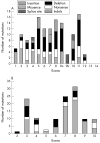Hereditary haemorrhagic telangiectasia: current views on genetics and mechanisms of disease
- PMID: 15879500
- PMCID: PMC2603035
- DOI: 10.1136/jmg.2005.030833
Hereditary haemorrhagic telangiectasia: current views on genetics and mechanisms of disease
Abstract
Hereditary haemorrhagic telangiectasia (HHT) is an autosomal dominant disorder characterised by epistaxis, telangiectases, and multiorgan vascular dysplasia. The two major types of disease, HHT1 and HHT2, are caused by mutations in the ENG (endoglin) and ACVRL1 genes, respectively. The corresponding endoglin and ALK-1 proteins are specific endothelial receptors of the transforming growth factor beta superfamily essential for maintaining vascular integrity. Many mutations have been identified in ENG and ACVRL1 genes and support the haploinsufficiency model for HHT. Two more genes have recently been implicated in HHT: MADH4 mutated in a combined syndrome of juvenile polyposis and HHT (JPHT), and an unidentified HHT3 gene linked to chromosome 5. Current knowledge on the genetics of HHT is summarised, including the pathways that link the genes responsible for HHT and the potential mechanisms underlying the pathogenesis of the disease.
Conflict of interest statement
Conflicts of interest: none declared
References
-
- Guttmacher A E, Marchuk D A, White R I. Hereditary hemorrhagic telangiectasia. N Engl J Med 1995333918–924. - PubMed
-
- Dakeishi M, Shioya T, Wada Y, Shindo T, Otaka K, Manabe M, Nozaki J, Inoue S, Koizumi A. Genetic epidemiology of hereditary haemorrhagic telangiectasia in a local community in the northern part of Japan. Hum Mutat 200219140–148. - PubMed
-
- Kjeldsen A D, Vase P, Green A. Hereditary haemorrhagic telangiectasia: a population‐based study of prevalence and mortality in Danish patients. J Intern Med 199924531–39. - PubMed
-
- Plauchu H, Bideau A. Epidemiologie et constitution d'un registre de population a propos d'une concentration geographique d'une maladie hereditaire rare. Population 19844–5765–786.
-
- Bideau A, Plauchu H, Jacquard A, Robert J M, Desjardins B. Genetic aspects of Rendu‐Osler disease in Haut‐Jura: convergence of methodological approaches of historic demography and medical genetics. J Genet Hum 198028127–147. - PubMed
Publication types
MeSH terms
Substances
LinkOut - more resources
Full Text Sources
Other Literature Sources
Miscellaneous



